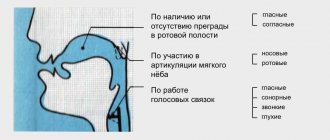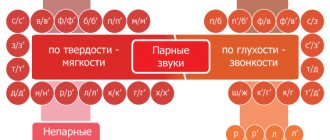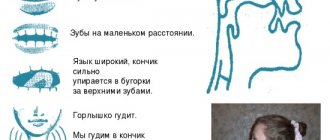Vowel sounds - sonants - consist of a voice, a musical tone formed as a result of rhythmic vibrations of the vocal cords. The oral cavity acts as a resonator: overtones (additional tones) are formed here, thanks to which each vowel sounds in a special way and has its own color (timbre). The nature of the overtones depends on the shape of the resonator, and in the oral cavity this shape is regulated by different positions of the tongue and lips.
For the articulatory classification of vowels in the modern Russian language, three features are most important:
- height of the back of the tongue;
- place of tongue elevation;
- labialization.
Let's look at each sign in turn.
Place of tongue elevation
This is also called the vowel formation zone. This takes into account the articulatory movements of the tongue in the horizontal plane. Based on this feature, vowels are distinguished:
- the front row, during the articulation of which the tongue moves forward and its front part rises to the palate: [i], [e];
- back row. The tongue moves back and the back of its back rises: [o], [y];
- middle row. When articulating them, the tongue does not change its horizontal position: [a], [s].
CLASSIFICATION OF THE SOUNDS OF THE RUSSIAN LANGUAGE material on speech therapy on the topic
CLASSIFICATION OF THE SOUNDS OF THE RUSSIAN LANGUAGE
Sound from an acoustic point of view is the vibration of air particles. The source is the vibration of sound chords. From the point of view of articulation, vowels and consonants of speech are distinguished.
Articulation is a set of actions of the organs of pronunciation at the moment of sound.
According to articulatory characteristics, all speech sounds are divided into two groups:
- vowels;
- consonants.
The main criterion for this division is the presence or absence of an obstacle in the oral cavity when pronouncing them.
There are 42 speech sounds in the Russian language: 6 vowels, 36 consonants.
CLASSIFICATION OF VOWEL SOUNDS
All vowels of the Russian language are characterized by the presence of a voice (phonation), their articulation is caused by the vibration of the vocal cords and the free passage of exhaled air through the oral cavity.
Tonal sounds are those produced by the voice in the almost complete absence of noise, which ensures good audibility of the sound: vowels a, e, i, o, u, s. Vowels are distinguished according to the following characteristics:
1. When forming vowels, not the entire tongue rises to the palate, but its front, middle or back part. Due to this, the volume and shape of the oral cavity changes.
By row (position of the tongue in the horizontal plane):
- front vowels: [i] [e];
- middle vowels: [s] [a];
- back vowels: [u] [o];
2. According to the degree of elevation of the tongue to the palate (its position in the vertical plane): upper, middle and lower elevation:
- high vowels: [i], [s], [u];
- mid-rise vowels: [e], [o];
- low vowels: [a];
3. By the presence or absence of labialization, i.e. degrees of lip participation: rounded (labialized) and unrounded (non-labialized) vowels:
- labialized vowels: [u], [o];
- non-labialized vowels: [i], [s], [e], [a].
CLASSIFICATION OF CONSONANTS
The articulation of consonant sounds is associated with the presence of some noise-generating barrier to the stream of air escaping from the lungs. The consonants of the Russian language differ in the following ways:
1. Classification of consonant sounds according to the method of formation:
- fricatives (fricatives) [f], [f'], [v], [v'], [s], [s'], [z], [z'], [w], [zh], [sch ], [j], [x], [x'];
- stop plosives [p], [p'], [b], [b'], [t], [t'], [d], [d'], [k], [k'], [g ], [G'];
- occlusive fricatives (affricates) [ts], [h];
- occlusive passages [m], [m'], [n], [n'], [l], [l'];
- trembling (vibrants) [р], [p']
Slit sounds are an obstacle to the air stream in the form of a gap between the organs of articulation.
The stop-plosive organs of articulation form a stop, which then explodes noisily.
Bow-cleft - the bow does not explode, but slowly turns into a gap.
Occlusion-passage - the organs of articulation form a bow, but there remains a passage for the air stream in another place.
Trembling - the raised tip of the tongue vibrates.
2. Classification of consonant sounds according to place of formation:
Labial:
- labiolabial [p], [p'], [b], [b'], [m], [m'];
- labiodental [f], [f'], [v], [v'];
Language:
- anterior lingual (formed by the front part of the back of the tongue, with different positions of the tip of the tongue), the tip of the tongue at the top - [t], [d], [n], [l], [l'], [p], [p'J, [ w], [f], [sch], [h]; tip of the tongue below - [t'], [d'], [n'], [s], [s'], [z], [z'], [ts];
- middle language [j];
- back-lingual [k], [k'], [g], [g'], [x], [x']
3. Classification of consonant sounds according to the degree of tension in the middle part of the back of the tongue:
soft: [j], [sch], [h] - always soft; [t'], [d'], [n'], [b'], [c'], [g'], [s'], [p'], etc.;
hard: [w], [zh], [ts] - always hard; [t], [d], [n], [b], [c], [g], [s], [r], etc.
4. According to the position of the soft palate (place of resonance), consonant sounds are divided into:
- nasal consonants {the soft palate is lowered, air passes through the nose}: [m] [m] [n] [n];
- oral consonants {soft palate raised}: all other consonants.
According to acoustic characteristics there are:
To identify and distinguish speech sounds, they rely not only on their articulatory, but also on acoustic features. Without relying on these signs, it is impossible to carry out work on contrasting sounds by ear, which is necessary for children to successfully master correct sound pronunciation.
5. The presence or absence of vibration of the vocal cords Sonorant (sonorous) - their quality is determined by the nature of the sound of the voice, which plays a major role in their formation, and noise participates to a minimal extent: consonants m, m', n, n', l, l', p, p', j.
Noisy - their quality is determined by the nature of the noise - the acoustic effect of air friction when the speech organs are close together or an explosion when they are closed:
voiced voiceless
- voiced noisy continuous v, v', z, z', w;
- voiced noisy instantaneous b, b', d, d', d, d';
- dull noisy continuous f, f', s, s', w, x, x';
- dull noisy instantaneous p, p', t, t', k, k'.
Based on the acoustic impression produced by sounds, the following subgroups of sounds are distinguished: whistling sounds s, s', z, z', z; hissing w, w, h, shch; solid p, v, w, g, c, etc.; soft p', v', h, shch, etc.
Labialization
Labialization is the position of the lips during articulation in which they are extended forward and rounded, which increases the anterior part of the oral cavity. In relation to this feature, two groups of vowels are distinguished:
- labialized (rounded), during the formation of which the lips are extended into a tube: [o], [y];
- non-labialized (not rounded), during the articulation of which the lips are in a neutral or stretched position. In Russian, these are all vowels except [o] and [u].
What are vowel sounds?
Our speech consists of words. Each word in turn is made up of sounds. In order for sound to appear, we use various organs: lungs, windpipe, larynx, mouth, tongue, nose and lips. With the help of the speech organs, a person can pronounce sounds that merge into a word.
The sounds in the word are not the same. Some sounds are made by voice, while others consist of noise and voice. When we begin to speak, we exhale air from the lungs, which rushes down the windpipe into the larynx. The larynx contains the vocal cords. If a stream of air passes freely through them and then does not encounter any obstacles on its path, then the result is a vocal sound consisting of a tone. If, when exhaling, the air makes its way through various obstacles, then a characteristic noise is obtained, typical of consonant sounds.
The term “vowel” is related in meaning to the word “voice”.
It is enough to change the position of your lips and you will get different vowel sounds with your voice. We can verify this if we say the following words:
- house
- chair
- ball
- roar
- shooting gallery
- poem
To form the vowel sound [o], it is enough to round the lips, and by stretching them out with a tube, we get the sound [u]. The vowel sound [a] is pronounced with the mouth wide open. The sound [and] requires you to stretch your lips in a smile.
So, in the Russian language there are six vowel sounds. These sounds in writing are indicated by the corresponding letters:
Vowels
oh, a, y, and, s, uh
Vowels differ from consonant sounds in that they can be pronounced for a long time or sung:
- a-a-ah
- aww
- oh-oh-oh
- i-i-il
Vowels by the degree of vertical movement of the tongue, that is, by rise
According to the way the tongue rises to the palate, vowel sounds are:
- Top rise. These are the sounds [i], [s], [u]. They are formed when the tongue rises as high as possible. These sounds are also called narrow.
- The middle rise is the sounds [e], [o]. During their formation, the tongue drops slightly lower than during the formation of the previous ones.
- Bottom rise is the sound . It is formed when the tongue is lowered as low as possible. This sound is also called wide.
The lower the rise, the wider the mouth opens and the lower the jaw drops.
Characteristics of vowels in the table
The phonetic transcription system uses all the vowels of the Russian alphabet, except for ya, yu, e, ё, which in Russian graphics denote the same sounds as a, u, e, o after soft consonants or a combination of sounds [ya], [yu] , [ye], [yo]. Thus, each vowel can be determined by a combination of three characteristics inherent in it. For example:
[e] - middle instep, front row, non-labialized, [y] - upper instep, back row, labialized, etc.
In the table, the composition of vowels of the Russian literary language with their characteristics can be presented in the following form:
| Climb | Row | ||
| front | average | rear | |
| Upper | And | s | at |
| Average | uh | O | |
| Lower | A | ||
| Non-labialized | Round | ||
The articulatory classification of vowels is studied in the section of the Russian language - phonetics. In order to pronounce words correctly, you need to know where vowel sounds are formed in the articulation apparatus.
Dependence of vowel sounds on the softness of consonants
Changes in the pronunciation of vowels depending on soft (palatalized) consonants are considered by phonetics. The classification of vowel sounds depending on such proximity can be presented as follows:
- The vowels ['a], ['e], ['o], ['u] move slightly upward and forward at the beginning of pronunciation.
- If these vowels stand between soft consonants, changes in articulation persist throughout the entire pronunciation of the sound: son-in-law [z'a't'], aunt [t'o't'a], tulle [t'u'l'].
Phonetics Basics
Bolycheva E. M.
Sound and letter
Sound is the minimal, indivisible unit of speech flow perceived by the ear. A letter is a graphic designation of a sound in writing, that is, a certain set of lines, a pattern.
The terms “sound” and “letter” must not be mixed. The words what and who are distinguished by the sounds [w] and [k], and not by letters. Sounds are pronounced and heard, letters are written and read. Other relationships are impossible: a letter cannot be pronounced, sung, spoken, recited, it cannot be heard. Letters are neither hard nor soft, nor deaf, nor voiced, nor stressed, nor unstressed. All characteristics given refer to sounds. These sounds are linguistic units, while letters belong to the alphabet and most often have nothing to do with the description of linguistic patterns. It is the quality of the sound that determines the choice of letter, and not vice versa. Sounds exist in any language, whether it is written or not.
Unlike other linguistic units (morphemes, words, phrases, sentences), sound itself has no meaning. At the same time, the existence of sounds is inextricably linked with meaningful units. The function of sounds in language is aimed at ensuring the possibility of communication between people and comes down to the formation and differentiation of morphemes and words.
When determining the distinctiveness of sounds, it is important to understand in what positions they occur. Position refers to the conditions for the pronunciation of sounds, specified by their position in relation to neighboring sounds, to a stressed syllable, to the beginning/end of a word. Only those sounds that have the ability to occur in the same position can distinguish words (morphemes). The difference in the pronunciation of such sounds is noticed by native speakers in contrast to other sound features.
The Russian alphabet is called Cyrillic and has 33 letters. To denote consonant sounds, 21 letters are used: b, v, g, d, g, z, j, k, l, m, n, p, r, s, t, f, x, c, ch, sh, sch. 10 letters are used to denote vowel sounds: a, u, o, y, e, i, yu, e, i, e. There are 2 more letters that do not denote sounds: ъ, ь.
There may be a mirror correspondence between the phonetic and graphic appearance of a word: [volume] volume. However, such a correspondence is not necessary: the word [p'at'] has three sounds, and it is written with four letters - five.
Letters have "multiple meanings", which are removed if adjacent letters/spaces are known. Thus, the letter е in the word fir-tree denotes the sound [j] and the sound [o], in the word heifer - a sign of softness of the consonant ['] and the vowel sound [o], and in the word silk - one vowel sound [o].
Page 1 - 1 of 10 Home |
Prev. | 1 | Track. | End | All © All rights reserved
Acoustic classification of vowels
All vowel sounds are formed using the tone of the voice. They can be either impacted or unaccented. It depends on their location in a particular word. Depending on this, vowels are called strong or weak. In the second case, the sounds are short in sound. When pronouncing them, no tension on the vocal cords is required. Strong vowels sound longer. When pronouncing them, you will need to strain your vocal cords.
Vowel tone is a non-self-distinguishing characteristic. It can convey the emotional state of the speaker or the grammatical meaning of a phrase or sentence. For example, if they are interrogative, then the vowel that carries the greatest semantic load is pronounced in a higher tone.
Phonetics
Phonetics is designed to study speech sounds. It occupies a special position, which is determined by the fact that the subject of its study is language units of a material nature. Sounding speech is formed by the human speech organs and air vibrations. The perception of sounding speech occurs through the human hearing organs.
Phonetics deals with the most minimal unit of language - the sound of speech. There are an infinite number of such sounds. After all, everyone pronounces them in their own way. But among this variety we can identify sounds that are pronounced in the same way. The method of formation is the basis for the classification of sounds.
The main thing that phonetics studies is the classification of vowels and consonants. Articulatory and acoustically, speech sounds are either vowels or consonants. Vowels provide speech with melodiousness. Consonants are noise.
When air flows freely from the lungs through the vocal cords and oral cavity, sounds called vowels are formed. They differ only in the overtones formed by the movements of the tongue and lips.
Consonant sounds are produced when air overcomes obstacles in its path. They consist of voice and noise or only noise. Different ways of forming and overcoming these obstacles make it possible to distinguish consonant sounds from each other. The classification of vowel/consonant sounds in the Russian language is based on these differences. We will consider its principles further.
Phonetics is a branch of linguistics that studies the articulatory and acoustic features of speech sounds. Articulatory phonetics deals with the study of the anatomical and physiological nature of sound and the mechanisms of its production. Acoustic phonetics studies sound as oscillatory movements carried out by its passage through the vocal cords and oral cavity. The subjects of study of acoustic phonetics are its pitch, strength, longitude and timbre.
Interesting facts about the vowel sounds “a” and “o”
The vowel sound “a” is one of the main and most common in many languages of the world. This is the first thing a newborn baby learns to pronounce. Experts say that the sound “a” is present in absolutely all languages of the world. By the way, in Ubykh this is the only vowel. Symbolism experts believe that all letters are derived from “a”.
The letter "a" is of Phoenician origin, like many others. In the graphics of many alphabets it is depicted as a triangle with a crossbar in the middle. Experts believe that it symbolizes the head of a bull. This animal was especially revered by the Phoenicians. In Christianity, the vowel letter “a” corresponds to the five wounds of Jesus Christ.
The sound "o" is the most ancient. The letter was included in the Phoenician alphabet more than 3 thousand years ago. She hasn't changed since then. In church and Old Church Slavonic alphabets, the letter sounds like “on”.





